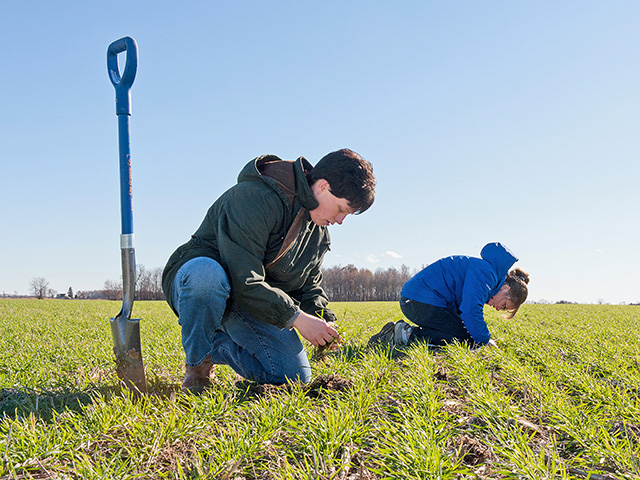This yearlong endeavor looks at how four farmers are evaluating technology and agronomic information that can boost the productivity of their operations.

Spend money where it makes money is the philosophy that guides Carmen Hawk's crop input purchases. The Shelbyville, Ind., farmer says her family's goal of harvesting 100-bushel-per-acre wheat in 2016 is putting her disciplined buying approach to a tougher test than usual.
"It's going to be a tight year for profits," notes Hawk, who farms with her dad, Mark Nigh, and brother, Ryan. "But buying inputs that return more than they cost makes sense. Our farm's soils have the potential to produce good wheat yields."
Proof of that potential is the farm's 2015 soft red winter wheat crop. It averaged 90 bushels per acre, despite several drowned-out spots that resulted from an unusually wet spring.
The family grows between 100 and 200 acres of winter wheat each year. They also produce corn and soybeans. All the wheat is double-cropped. They plant soybeans immediately after wheat, provided weather and soil conditions allow.
"The wheat crop enables us to make more use of the equipment we already own, like our air seeder, self-propelled sprayer and combine," Hawk notes. "And it brings in money during the summer, which helps cash-flow."
Hawk brings a strong financial background to the family farm's day-to-day operations. She earned a bachelor's degree in agricultural economics from Purdue University. A job with a major agricultural retailer gave her input-pricing and crop-consulting experience, both of which she taps into today on her family's operation.
One way Hawk recently harnessed her knowledge and experience was when the family decided to try high-intensity wheat management.
"Prior to 2014, Dad had good wheat crops, but he wasn't pushing for high yields," Hawk recalls. Nitrogen was applied in one pass, and fungicides, herbicides and insecticides were used only "as needed." Still, the farm averaged a respectable 75 bushels per acre in 2013.
In 2014, Hawk and her family went with a program that included split applications of nitrogen and set fungicide and herbicide applications.
"We split-applied UAN 28%, and sprayed an application of Priaxor fungicide in early spring and followed that 24 days later with an application of Caramba fungicide, tank-mixed with a broadleaf herbicide," Hawk notes.
That program gave the family a 90-bushel-per-acre wheat crop. "I think split-applying the nitrogen was a big factor behind our increase," she says.
Prior to seeding the 2015–16 wheat crop, Nicole Mercer, an Innovation Specialist for BASF, approached Hawk with an offer. Mercer wanted to conduct a trial to test if making a fall application of Priaxor would raise wheat yields a notch.
"Priaxor promotes tillering, deeper rooting and reduces winter kill in wheat, in addition to controlling a large variety of fungi," says Mercer.
Priaxor was applied Oct. 17, 2015, at the Feekes 3 stage. Check strips were established, so differences between treated and untreated wheat could be measured.
A root dig by Hawk and Mercer on Nov. 13, 2015, found better wheat rooting and larger plants in some of the Priaxor fungicide-treated areas. Hawk says a second Priaxor application will be made and evaluated the end of April 2016. An application of Caramba fungicide—to control head scab—will follow around the end of May.
The family's nitrogen program will remain the same as what they used in 2015. "We'll make an early April application of UAN 28% at 65 pounds per acre. At the end of April we'll apply another 45 pounds per acre of UAN 28%," Hawk says.
The wheat fields will continue to be monitored and compared through the 2016 harvest.